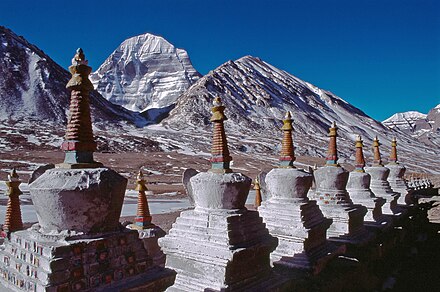Mount Kailash - mountain in Tibet, China
Mount Kailash (Tibetan: Kang Rinpoche) is a sacred mountain in the far west of Tibet.
Understand

This mountain is considered holy by Hindus, Buddhists and Jains. In ancient texts, it is referred to as the center of the world. The reason can be understood from the geographical significance of its place: within a radius are the sources of mighty rivers Indus (to the north, called "Sindhu" in India), Sutlej (to the west), Brahmaputra (Yarlung Tsang-po, to the east), and Karnali (the largest tributary to the Ganges, to the south).
History
Hindus regard the peak as Shiva's symbolic 'Lingam' and worship Mt. Kailash, which is the Sanskrit name for the mountain. Bonpos believe the sacred mountain to be the place where the founder of the Bon religion landed when he descended from the sky. Tibetan Buddhists believe Kang Rinpoche, which means Precious Snow Mountain, is a natural mandala representing the Buddhist cosmology on the earth and the Jains believe this is the place where their religion's founder was spiritually awakened.
Myths and legends
There are many myths and legends that have encouraged the enigma surrounding Kailash Mountain. Standing out in an indescribably beautiful landscape, where no other relief rises above it, Mount Kailash is believed by Hindus to be the seat of Shiva in his eternal meditation.
Landscape
Flora and fauna
Climate
Prepare
Get in
There are only four land routes to reach Mt. Kailash.
- From Xigatse (accessible from Lhasa or Kathmandu) - Saga - Manasarovar (4 days on a hired jeep, longer by a combination of public transportation and hitch-hiking) or Xigatse - Ali - Darchen (6 days on a jeep)
- From Indian border near Uttarkashi (very limited number of Indian citizens every year by lottery system).
- from Kashgar via Ali
- from Simikot/Hilsa in Nepal via Purang (helicopter ride to Hilsa makes it fast but expensive)
The entry point for Mt. Kailash is Darchen. Located right in front of Mt Kailash, this is the starting point for pilgrims going on the Khora.
Fees and permits
¥50 per person no matter how many times they circumambulate the mountain on one visit. Porters or yaks will cost about ¥65 per day.
Get around
The main attraction of the mountain is the pilgrimage circuit around the mountain. It normally takes 3 days and should only be undertaken by the well-prepared and fit.
Itinerary
-
Mt Kailash Khora (Pilgrimage Circuit) - A pilgrimage to Mt Kailash involves nothing more or less than making circuits around the sacred mountain. The Outer Pilgrimage Circuit (Chikhor) is about 52 km, and Tibetans can complete a circuit in a day. The majority of pilgrims try for 13 circuits, if they can. Some pilgrims do a circuit performing Kyangcha (Prostration). While the average circuit takes about 14 hours to complete, those doing prostration can take a couple of weeks. Those seeking to secure their path to enlightenment try for 108 circuits. Buddhists and Hindus travel clockwise around the mountain while Bonpos travel counter-clockwise. Most travelers take three days to complete a circuit.
-
Day 1 - Darchen - Drirapuk Gompa
Darchen - Chogu (Chuku) Gompa (3-4 hr), Chogu (Chuku) Gompa - Drirapuk Gompa (3-4 hr)
- Day 2 - Drirapuk Gompa - Dolma La - Zutrulpuk Gompa
Drirapuk Gompa - Zutrulpuk Gompa (7-8 hr)
- Day 3 - Zutrulpuk Gompa - Darchen
Zutrulpuk Gompa - Darchen (3 hr)
-
Lake Manasarovar Khora (Pilgrimage Circuit) - Together with Mt Kailash, Lake Manasarovar is a pilgrimage site. There is a pilgrimage path around the lake and a circuit is a little over 100 km, taking 4-5 days to complete. Chiu Gompa, 30 km south of Darchen, is a good starting point for a circuit around the lake.
-
Day 1 - Chiu Gompa - Langbona Gompa
-
Day 2 - Langbona Gompa - Seralung Gompa
-
Day 3 - Seralung Gompa - Trugo Gompa
-
Day 4 - Trugo Gompa - Chiu Gompa
See
Do
- Mt. Kailash Khora - the pilgrimage circuit
- Lake Manasarovar Khora - another pilgrimage circuit
Buy
- undefined. Not much choice as the handicrafts (made in China) are either duplicates or of no use except for giving as gifts to friends.
Eat
Drink
Water that flows from springs is very refreshing as it has mineral content.
Sleep
Lodging
Camping
Backcountry
Stay safe
Weather conditions can change rapidly here and you should be prepared for the worst.
It's unlikely you will have problems with the altitude other than shortness of breath and less energy than you are used to, as you will have been at altitude for quite some time just to get here. However, altitude sickness is unpredictable, and you should always keep your plans flexible enough to give yourself a rest day if needed.
Respect
- Do not sit or climb on sacred sites.
- Pass mani stones to the right.
- Turn prayer wheels in a clockwise direction.
Related: Ngari (prefecture)
Ngari Prefecture
2nd-order administrative division
Tibet
Primary administrative division